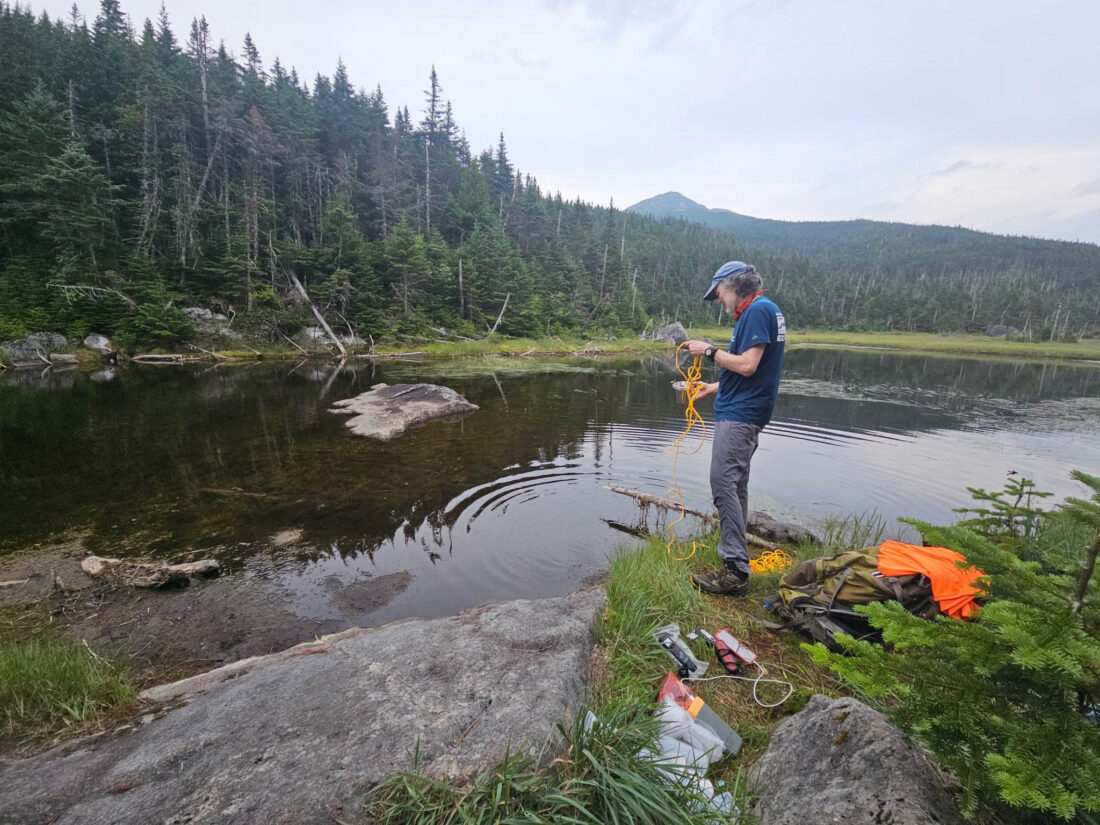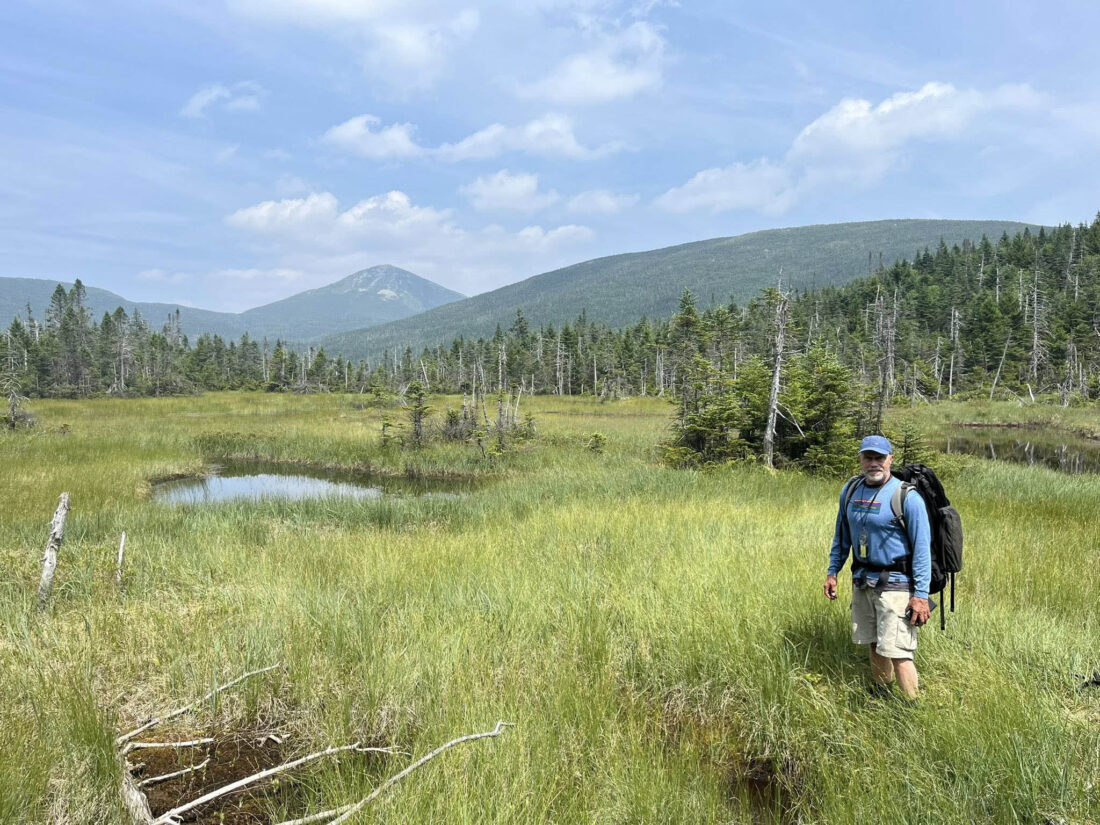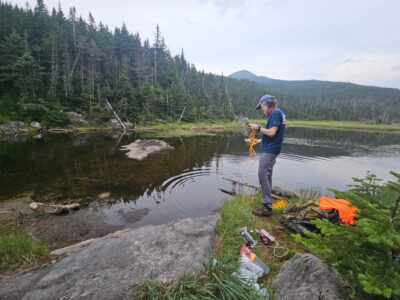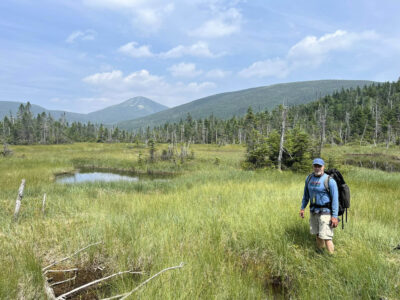Plastic pollution in Lake Tear of the Clouds
High microplastics levels discovered in a source of Hudson River; hiker clothing, shoes may be responsible
- Tim Keyes takes water samples from Lake Tear of the Clouds below the summit of Mount Marcy. The samples collected there in July showed nearly twice the concentration of microplastics as they did in 2023, and significantly more than in more remote nearby water bodies. (Provided photo — Joe Dadey)
- Joe Dadey prepares to take water samples from Moss Pond below the summit of Mount Redfield. Mount Marcy can be seen in the background. The samples collected there in July showed low concentration of microplastics, but samples taken at nearby, more trafficked Lake Tear of the Clouds showed high levels. (Provided photo — Tim Keyes)

Tim Keyes takes water samples from Lake Tear of the Clouds below the summit of Mount Marcy. The samples collected there in July showed nearly twice the concentration of microplastics as they did in 2023, and significantly more than in more remote nearby water bodies. (Provided photo — Joe Dadey)
SARANAC LAKE — Microplastics have been detected in increasing levels at Lake Tear of the Clouds, the highest source for the Hudson River. According to a new report from local researchers and citizen scientists, hikers wearing synthetic clothing or soft-soled shoes may be unwittingly contributing to microplastic concentrations, even in the most pristine areas of the High Peaks.
Microplastics are omnipresent in the environment. This invisible pollution can shed from clothing, or from wear and tear on shoes, and appears to be a significant contributor to microplastic concentrations in remote areas, according to the report. Data scientist Tim Keyes likens it to the character Pig-Pen from the comic strip “Peanuts,” who carries a dirt cloud around wherever he goes.
There is no imminent danger to human health or the environment, but researchers have concerns about increasing concentration and potential toxic buildup of the particles in living organisms over time.
In 2023, Hamlets to Huts co-founder Joe Dadey and former board member Keyes helped lead a group of students and teachers on the “Hudson River Source to Sea Expedition” along the entire length of the Hudson — 375 miles from Mount Marcy to the Atlantic Ocean by New York City in 15 days. They collected water quality samples along the way as a bit of citizen science, or “adventure science.”
The eight students came from near and far — Sage Kite-Whidden from Saranac Lake, Cole Sears from North Creek, two students from California and four from New Jersey.

Joe Dadey prepares to take water samples from Moss Pond below the summit of Mount Redfield. Mount Marcy can be seen in the background. The samples collected there in July showed low concentration of microplastics, but samples taken at nearby, more trafficked Lake Tear of the Clouds showed high levels. (Provided photo — Tim Keyes)
They did not expect Lake Tear of the Clouds to have elevated microplastics concentrations, so they were surprised when the results came back showing 9.45 particles per milliliter there.
“We were disappointed and astonished,” Keyes said.
They knew they had to return for more research.
In July, they hiked back out to the lake to take more samples. First, they climbed from Upper Works to Moss Pond below the summit of Mount Redfield. Moss Pond is around one mile away from Lake Tear and almost at the same elevation. It is more remote, trailless and feeds the Hudson independently.
They were surprised by how low the microplastic concentration in the Moss Pond samples were — just 0.73 particles per mL, an “order of magnitude” lower than at Lake Tear in 2023, and close to the “field blank” they used to get a base level of microplastics from the water being carried in vials.
And when they returned to Lake Tear this summer, the microplastic concentration in the samples was nearly twice as high as it had been just two years ago — an average of 16.54 particles per mL, compared to the 9.45 particles per mL measured in 2023. They took three samples from the outlet of each water body.
The full report can be read at tinyurl.com/mups8xsr.
–
How did it get there?
–
They had initially thought Lake Tear’s microplastics came from airborne deposits. But they felt these new findings “strongly suggest” that foot traffic from hikers and the clothing and gear they carry are responsible.
The highest concentrations of microplastics in the entire river measured in 2023 were 21.42 in North Creek and 28.94 in Glens Falls.
Dadey and Keyes said they felt shocked realizing they had been contributing to microplastic pollution.
They are asking people to make changes — even small ones — in an effort to change learning and behavior over time.
“We’re not saying ‘Oh my God, people need to stop going to Lake Tear of the Clouds or hiking the High Peaks,’ absolutely not,” Dadey said.
He said their message is to take precautions to minimize impact on the environment, learn and spread news.
Lake Tear of the Clouds stands at 4,293 feet elevation, around 1,000 feet below the summit of Mount Marcy — the tallest peak in the state. It gets its name from being the highest source for the Hudson River. It is also on a commonly used route to get to three popular High Peaks — Marcy, Gray and Skylight.
“Almost no one goes to Moss Pond, and a lot of people go to Lake Tear of the Clouds to get to these peaks,” Keyes said.
“There’s probably a modicum of airborne deposition involved, but from the contrast with Moss Lake, it appears that a major contributor may be treadwear — the boot or shoe treads disintegrating,” Keyes said, “just like when we drive down the road and a known major source of microplastics in the front country is our tires disintegrating.”
They attribute the significant increase in microplastics found in Lake Tear between 2023 and 2025 to the rising popularity of hiking the High Peaks.
Keyes completed his 46th High Peak in August 2012, becoming number 7,630 on the official Adirondack 46ers’ roster. The roster had taken 87 years to reach that number. In the 13 years since, it has more than doubled — now with more than 16,000 members.
“It’s reasonable to assume that the number of hikers not pursuing the 46 High Peaks but still visiting the area has escalated similarly,” Keyes said.
The state Department of Environmental Conservation and the Adirondack Mountain Club report that their summit stewards educated almost 32,000 hikers in 2024.
Keyes said the source of the microplastics in the mountain water could be from something else — they’re not discounting that. He feels the next step will be “fingerprinting” — determining what sources these microplastics came from.
–
What are microplastics?
–
Microplastics are tiny plastic beads that have spread throughout the world through the breakdown of plastic objects, synthetic clothing, cosmetics, tires, packaging, bottles and other everyday human-created goods.
“That’s the problem with microplastics. We all have this convenience factor. Because plastics are very convenient,” Keyes said. “But as it degrades, it’s invisible.”
They are classified as plastics measuring between 1 micrometer to 5 millimeters in size. Anything smaller is a nanoplastic. A micrometer is also called a micron. For reference, human hair is around 90 microns and red blood cells are around 7 microns.
“We inhale microplastics when we breathe, we ingest them through drinking and eating and they can also be absorbed through our skin,” according to the report.
More than 70% of microplastics in the oceans are from clothes, textiles and fishing gear, according to the National Oceanography Centre. Based on the samples collected along the Hudson River in 2023, they found microplastic concentrations spike downstream from wastewater treatment plants. When clothes are washed, the fibers they shed end up in the river.
Microplastics are just starting to be studied. Their impact on humans and the environment are still yet to be fully understood.
In humans, studies have found they may be linked to cancer, inflammation, immune system dysfunction, cardiovascular issues, endocrine disruption, heart attacks, reproductive problems and other health problems. They accumulate in the brain, in the endocrine system and the reproductive system.
“In the environment, they contaminate ecosystems, disrupt food chains and potentially harm wildlife and plants through bioaccumulation,” according to the report.
Keyes said there may be a “tipping point” of microplastics severely impacting humans and the environment, but currently, he’s unsure where that is.
–
What to do
–
After dwelling on these results, Dadey and Keyes are rethinking their hiking attire. They recommend anyone who cares about the microplastics issue like them to make similar adjustments to their outdoors outfits.
Both said they plan to stop wearing synthetic clothing and instead wear natural fiber clothing — wool, hemp or bamboo. They both recommend merino wool, which is lighter and does not itch like traditional wool does. If they do wear synthetic clothing for moisture wicking properties, they wear it as a base layer, with a natural outer layer, to avoid shedding.
They are also paying more attention to their footwear– wearing shoes with hard rubber soles rather than ones with soft rubber soles. They recommend monitoring the degradation of footwear treads.
Keyes already records how many miles he puts on his cleats. He switched from boots to trail runners a number of years back, and noticed that they wear out faster. He’ll probably switch back to sturdier boots now, even if they are heavier.
These changes are not for everyone, he said, but it is something people can do.
A long-term change is underway in the outdoors industry, Keyes said, to persuade clothing manufacturers to pay attention to how their threads impact the environment. There are movements to guide the clothing supply chain in a new direction.
“This work underscores the reality that even our most remote and iconic headwaters are not immune to human impact,” Dadey said. “Lake Tear of the Clouds is a sacred source of the Hudson, yet our research shows it is already carrying the imprint of microplastics — likely from the very visitors who revere it.”
The study was done in partnership with Keyes’ firm, Evergreen Business Analytics. Microplastic analysis was conducted by Parverio, Inc.
Keyes also said they received support from Riverkeeper, the Adirondack Watershed Institute, SUNY Plattsburgh and the Rozalia Project.





